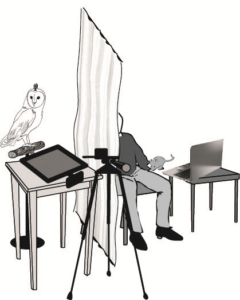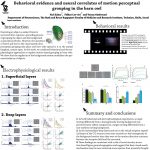Visual Search: Behavioral Experiments
Animals actively scan the environment to collect useful bits of information. This pr ocess, known as visual search, is highly studied in humans and animals. What attracts the visual gaze and how barn owls search for interesting stimuli are the main questions asked in this project. We combine kinematic measurements of head movements with tracking of gaze point. Experiments are performed in spontaneously behaving owls as well as with trained owls performing a controlled visual task on a computer screen. To measure the kinematics we attach infra-red reflectors to the owl’s head and track their position using a Vicon system. To follow in real-time the point of gaze of the owl a wireless miniature video camera is mounted on the head. Using these techniques, on-going experiments address the following topics: combining visual and auditory information for saliency mapping, detection of camouflaged objects, pop-out perception and the role of active head motions in visual perception. Results from the behavioral experiments are combined with results from physiological experiments conducted in our lab to gain an understanding of visual search mechanisms in barn owls.
ocess, known as visual search, is highly studied in humans and animals. What attracts the visual gaze and how barn owls search for interesting stimuli are the main questions asked in this project. We combine kinematic measurements of head movements with tracking of gaze point. Experiments are performed in spontaneously behaving owls as well as with trained owls performing a controlled visual task on a computer screen. To measure the kinematics we attach infra-red reflectors to the owl’s head and track their position using a Vicon system. To follow in real-time the point of gaze of the owl a wireless miniature video camera is mounted on the head. Using these techniques, on-going experiments address the following topics: combining visual and auditory information for saliency mapping, detection of camouflaged objects, pop-out perception and the role of active head motions in visual perception. Results from the behavioral experiments are combined with results from physiological experiments conducted in our lab to gain an understanding of visual search mechanisms in barn owls.
PROJECT LEADER: Tidhar Lev-Ari, Hadar Beeri
Related article:
- Hazan Y, Yarin I, Kra Y, Wagner H and Gutfreund Y (2015) Visual-auditory integration for visual search: a behavioral study in barn owls. Frontiers in Integrative Neuroscience. 13 February 2015 | doi: 10.3389/fnint.2015.00011
- Lev-Ari Tidhar, Dutta Arkadeb, Gutfreund Yoram. Studying Visual Behavior in Barn Owls with a Miniature Head-Mounted Video Camera. The 36th Annual Meeting of the Israeli Society for Vision and Eye Research, Kfar Maccabiah, Ramat Gan, Israel, 9.3.2016. (pp. 75).
- Lev-Ari Tidhar, Zahar Yael and Gutfreund Yoram, Behavioral evidence and neural correlates of motion perceptual grouping in the barn owl (Tyto alba). The 25th ISFN Annual Meeting, Eilat, Hilton Queen of Sheba, 4-6.12.2016.(pp. 5)
- Lev-Ari Tidhar, Dutta Arkadeb, Gutfreund Yoram. The use of head movement for camouflage breaking – behavioral and neural study in barn owls The 53thAnnual Meeting of the Zoological Society of Israel, The Robert H Smith Faculty of Agriculture, Food and Environment, The Hebrew University of Jerusalem, Rehovot, Israel, 25.12.2016.(pp. 34)
- Yael Zahar, Tidhar Lev-Ari, Herman Wagner and Yoram Gutfreund (2018) Behavioral evidence and neural correlates of perceptual grouping by motion in the barn owl. https://doi.org/10.1523/JNEUROSCI.0174-18.2018
- Lev-Ari, Tidhar. and Gutfreund, Yoram (2018) Interactions between top-down and bottom-up attention in barn owls (Tyto alba) Anim Cogn 21: 197-205.
Project Poster from the ISFN conference 2016 (click to enlarge):

